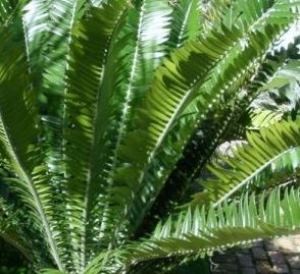Encephalartos pterogonus
(Encephalartos pterogonus)

Description
Encephalartos pterogonus is a species of cycad that is native to Mount Mruwere (Monte Urueri) and adjacent mountains in the Manica province of Mozambique. It is a cycad with an erect stem, up to 1.5 m tall and with a diameter of about 40 cm, sometimes with secondary stems that originate from suckers that arise at the base of the main stem. The leaves, pinnate, 1.2-1.5 m long, are arranged in a crown at the apex of the stem and are supported by a 4-8 cm long petiole; each leaf is composed of several pairs of dark green lanceolate leaflets, on average 15-18 cm long. It is a dioecious species with male specimens showing 1-3 cones, spindle-shaped, 30–38 cm long and 10–11 cm broad, pedunculated, and female specimens with 2-3 coarsely cylindrical cones, 35–40 cm long and with a diameter of 16-18 cm, bright green. The seeds are coarsely ovoid, 28–35 mm long, covered with an orange-red sarcotesta when ripe. Encephalartos is a genus of cycad native to Africa. Several species of Encephalartos are commonly referred to as bread trees, bread palms or kaffir bread,since a bread-like starchy food can be prepared from the centre of the stem. The genus name is derived from the Greek words en (within), kephalē (head), and artos (bread), referring to the use of the pith to make food. They are, in evolutionary terms, some of the most primitive living gymnosperms. All the species are endangered, some critically, due to their exploitation by collectors and traditional medicine gatherers. The whole genus is listed under CITES Appendix I which prohibits international trade in specimens of these species except for certain non-commercial motives, such as scientific research. Several of the species possess stout trunks. In E. cycadifolius, the main trunks are up to 10 feet (3.0 m) high, and several of them may be united at a base where a former main trunk once grew. The persistent, pinnate leaves are arranged in a terminal spreading crown, or ascending. The rigid leaflets are variously spiny or incised along their margins. The leaflets have a number of parallel veins and no central vein. Male cones are elongated, and three or four may appear at a time. Female cones are borne singly, or up to three at a time, and may weigh up to 60 pounds (27 kg). In some species, male cones with ripe pollen emit a nauseating odour. When the pollen has been shed and the males cones decay, a strong odour of acetic acid has also been noted.
Taxonomic tree:







